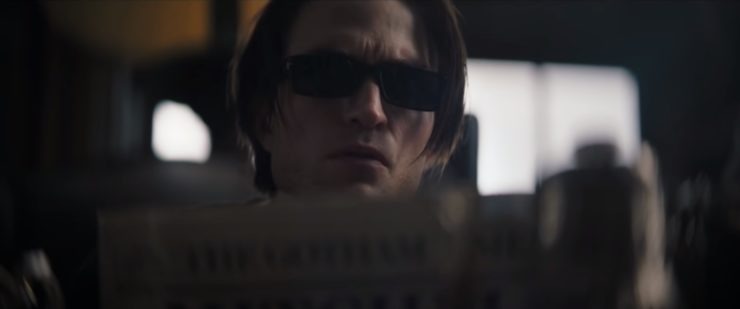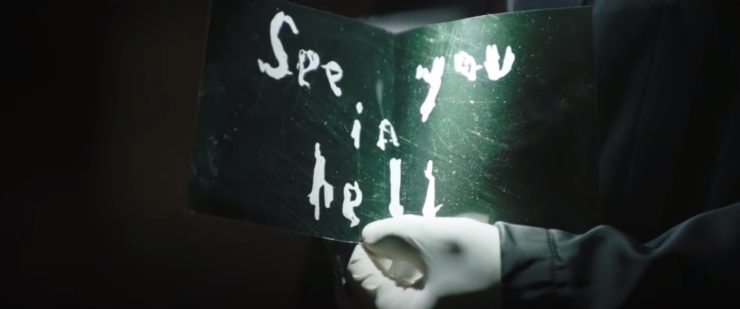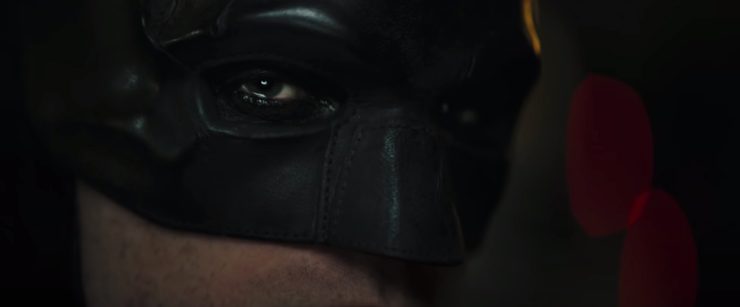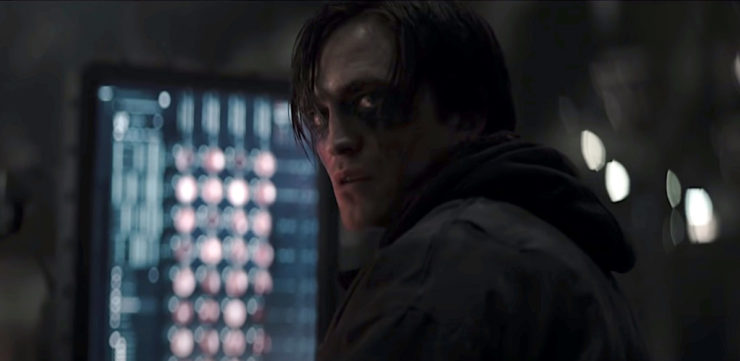Welcome to Close Reads! In this series, Leah Schnelbach and their guests dig into the tiny, weird moments of pop culture—from books to theme songs to viral internet hits—that have burrowed into our minds, found rent-stabilized apartments, started community gardens, and refused to be forced out by corporate interests. This time out, we muse on the music of…The Batman.
Nirvana’s “Something in the Way” is a haunted, desperate song. (And by the way it’s grunge, goth-adjacent grunge, but grunge, not emo. Battinson’s eye makeup? Emo. A grunge song from 1991? Not emo. “Ave Maria”? Also not emo.) On an album where even a horror story like “Polly” is pretty up tempo, “Something in the Way” stands out with its darkness and quiet.
Like a few tracks on Nevermind, it seems to be in conversation with the Baby Boomer Generation as a whole—something in the way she moves might attract George Harrison like no other lover, but in Cobain’s take, those words spill out into a story about living under a bridge. You got kicked out, or ran away, or your score is more important to you than rent, or you don’t have enough money for the bus. Who knows. What’s important is that you’ve scratched a life out under here, living off runoff water and fish that you tell yourself you can eat without guilt.
What’s important is that you are, somehow, still alive.
Predictably this is my favorite song on the album.
This song isn’t actually autobiographical, although Cobain was homeless for a while, and plenty of kids in Seattle and Aberdeen hung out under bridges. His friends and family have pushed back on the idea that he’s narrating his own experience. It’s more taking the feeling of desperation and homelessness, and the need to stay underground for your own safety, and creating an emotional reality.
When this song was featured in the trailer for The Batman I made the same jokes about The Crow that everyone made. But while I was watching the movie? When it kicked in, I got the immediate jolt of adrenaline I always get from this song, and it paired SO WELL with the gloomy tone the film had already set. I was all in. The song faded out and I waited for the next scene.
I was pretty happy.
But then it immediately started over. For a sec I was like, this is a bold choice, to use this again like this, but no—it’s diegetic. Bruce is listening to it, on a loop, while he works. (This is a thing he has in common with Matt Reeves, apparently.) We join him in his workroom when he’s about halfway through a second play, when Alfred comes in and interrupts him—and he kills the music exactly like a teen being interrupted by their dad. Because, with all due respect to parents, when you’re in a song you’re in it, and it hurts to come out.
This hit me because it’s what I’ve always done. I get stuck on songs sometimes, and have to repeat them on a loop as a self-soothing technique until they let go of me. I feel very real pain until I’ve listened to them enough—kind of an emotional eczema, if that makes sense. They’re especially necessary when I work, and once an album becomes my “work” album I need to play it while I write, loop after loop. And usually, much like Bruce, the thing that soothes my brain and helps me get into a groove of writing is darkity dark dark DARK.
(OK, occasionally joyful—I remember one day wandering around the Flatiron District listening to “Chicago” on a loop and being bowled over with delight each time Sufjan said “I went to Newww Yorrrrk, in a van, with my friends” because I did—I DID go to New York in a van with my friends, years before I ever lived here. I fell in love, I’m still in love, despite all the complications, New York City never failed me yet.)
But usually it’s the darker stuff—the Sad Bangers, as Hanif Abdurraqib mused on recently, leading to Molly Templeton’s excellent column—which isn’t quite the tone I reach for. Maybe mine are haunted bangers? It was Jim White’s “Still Waters” in the car back in Tampa, Joy Division’s “Atrocity Exhibition” blaring in my ears over and over on the train, it was Radiohead’s “Bodysnatchers” while I walked to a job I fucking hated. Last summer it was “I Know the End” as loud as I could stand it. Last fall it was “That’s What I Want” and “Blinding Lights” loud loud LOUD. This spring, so far, it’s been “Palmcorder Yajna” and “Wear Black”, both by the Mountain Goats. (There are days, a lot of them, when I have to hear these two many times in a row to get my brain to stop fizzing long enough to get any work done.)
If Batman showed up in my apartment and demanded that I had to find some common thread here or else Gotham was doomed, the best I could offer would be images: running water, evergreens in the rain, the shadows beneath bridges, undertow, wanting to disappear—whether into darkness or light. These were the songs I needed to live in to get through the day, and I’m not wallowing, exactly, but I’m not not wallowing either. But, as I say, it seems to be what I need.
This was the thing I was thinking of during The Batman.
If we ignore the de rigeur ‘90s secret track, “Endless, Nameless”, that was included on later pressings of Nevermind, “Something in the Way” is the song that ends one of the greatest albums ever made. This slow, sad, mysterious song is the one that casts you back into the world. It ebbs and swells, like a tide, like the river licking the perilous shelter under the bridge. The closest it comes to a peak is the rising cello, but even that acts more as a dark glass to the vocal. It has no resolution. The two verses repeat, the chorus repeats. You can start the song at the beginning, or in the middle. You can loop it forever. You can imagine it repeating until the water swallows us and we join the fish. Life under the tarp under the bridge is forever, it’s where you’ve always lived, and where you will always live.
But you are, at least, still alive.
The reason I wanted to write about this is that in the midst of a very over-the-top dirge-y Batman movie, Matt Reeves and his team got at a really interesting take on Bruce Wayne. His parents were murdered, he’s dedicated himself serving his City in a deeply weird way. But he’s chosen to stay in that moment. He doesn’t leave to be playboy Bruce Wayne, or surrogate son to Alfred, or lover to Selina. He has always lived under the bridge. This song is always playing.
The undercurrents of this song become the musical thread of the film’s soundtrack—or one of ‘em. Because “Something in the Way” is in conversation with another: “Ave Maria”, which is, startlingly, Riddler’s chosen theme song.
Or…maybe not chosen, exactly.

And now, a brief note from an actual music person, composer and music scholar Drake Andersen:
To my ears, what makes the soundtrack of The Batman especially compelling is the unique combination of scored and preexisting music that, despite enormous variation in style, nevertheless exhibits remarkable consistency in the musical details. This consistency is made especially clear by examining the musical intervals that make up each element. For example, the chords in Nirvana’s “Something in the Way” trace the musical interval of a descending major third. Elsewhere, the major third resurfaces—in ascending form—in the melody of Schubert’s “Ave Maria.” That this interval also underpins the main theme of “Westworld”, and gives several of the scenes with Jeffrey Wright a peculiar valence.
The other interval that seems to tie the soundtrack together is the minor second (think “Jaws”). While this interval is most apparent in a haunting musical cue played by the high strings, it is also the key to hearing the connection between “Ave Maria” and its minor-key adaptation sung by a solo female voice. What was once an ascending major third becomes a minor third, compressed by the interval of—you guessed it—a minor second! It’s not difficult to make a parallel between the idea of particular intervals or melodies reappearing in different guises and the story on screen. But whether or not this connection was intentional, following these subtle details can undoubtedly enhance our experience of the film.

So why “Ave Maria”? And what does it have to say to “Something in the Way”? (Aside from the obvious connection, that Kurt Cobain looked a lot like a white Warner Sallman Jesus.) Mary is the ultimate mother figure in some traditions, so having the orphaned Riddler drawn to the song for that reason could have been interesting, but it’s a little more complicated than that. “Ave Maria” plays at the opening of the film (as a non-diagetic, soundtrack-only song) when Riddler murders the mayor. We later learn that it was (diagetically) performed by a choir of orphans at the Wayne-funded orphanage, and, yes, one of the singers was a young Riddler. Rather than Schubert’s original adaptation of Walter Scott’s long poem The Lady of the Lake, in which “Ave Maria” was a plea made by a young woman for Mary’s protection from a cruel world, The Batman uses the later iteration—the Catholic prayer to Mary, set to Schubert’s music, and sung by children’s choirs for Christmas masses and mob movie soundtracks. This version is an acknowledgement of the fallen nature of the singer, and a request for intercession at said singer’s death. (If you don’t mind a brief editorial, it’s never sat right with me that anyone would make children sing this song? But then Augustine and I don’t often see eye-to-eye.)
However for our purposes here, this helps the song make sense. This day, when Riddler had to perform his grief in front of an audience of Gotham’s rich, a group of motherless children singing an ode to the Ultimate Mother—and then the reforms never come through? I can see why he’d fixate on this day and this song. It makes the moment he sings it to Batman, expecting understanding and not getting it, even more upsetting. He is extending his Sad Banger to the Bat, expecting that they’ll share it. But Batman has his own song.

Bruce has been Batmanning every night for two years. (…rather than joining the 27 Club, he took to vigilantism?) If Batman takes place in 2019 and Bruce is supposed to be around 30, that means that he was a toddler when “Something in the Way” came out. He was in high school for The Black Parade. He probably chimed in with a “Hasn’t Alfred ever heard of closing the goddamn door?” He most likely already had a loaded Gotham complex. “Something in the Way” was a choice, is my point, in the same way that The Velvet Underground and Joy Division were choices for me. Nirvana was not mother’s milk—this was a song that called to him, even though it had only been a well-liked-but-not-chart-burning-song, sung by a singer who was dead by the time he started kindergarten, from an album that was “classic rock” by the time he graduated college.
What I love is that in the background of this blockbuster superhero movie, a sad banger about teenage homelessness and a sad banger about Jesus’ mom battle it out for supremacy. A weird gloomy ‘90s song becomes a meditation for the “hero” doing his detective work, and a fragile, heartbreaking hymn is corrupted into the soundtrack to the “villain’s” murders. The songs themselves become Batman and Riddler’s “we’re not so different, you and I”. After years of movies that set Batman and his Rogues Gallery as mirrors of each other, people compelled by trauma to wear masks and commit or fight crime, the lines between them blurring with each film, The Batman finally makes a new kind of connection. Batman and Riddler aren’t “split…right down the middle.” They aren’t two sides of a tossed coin. Both are fully consumed by their obsessions. They are addicted to their work, and in order to get into the grooves of their respective work they choose to wallow. Batman has to listen to “Something in the Way” on repeat to trap himself forever in Crime Alley. He has always lived under the bridge. Riddler has to remain forever on that stage, performing his grief to the elite of Gotham, who do nothing to help him. He has to sing about forgiveness so he’ll never forgive.
When the water comes to Gotham it doesn’t wash the scum from the streets, or baptize anyone. Most of the elite survive, and, as ever, the people who’re hurt the worst are those scratching out lives in the city’s underbelly. Tarps under bridges. And maybe things will change in the sequel, but I think Riddler’s trapped forever, and I’m willing to bet Batman still has some wallowing in him.
Leah Schnelbach wears black wherever they go. Come lurk with them in the shadows of Twitter!
Drake Andersen is a composer and music scholar. He teaches electronic music at Vassar College. You can find his music and other projects at drakeandersen.com.










